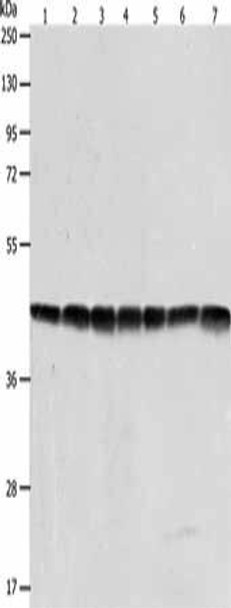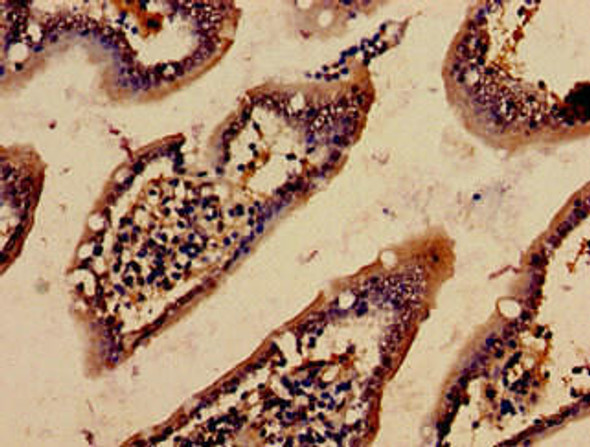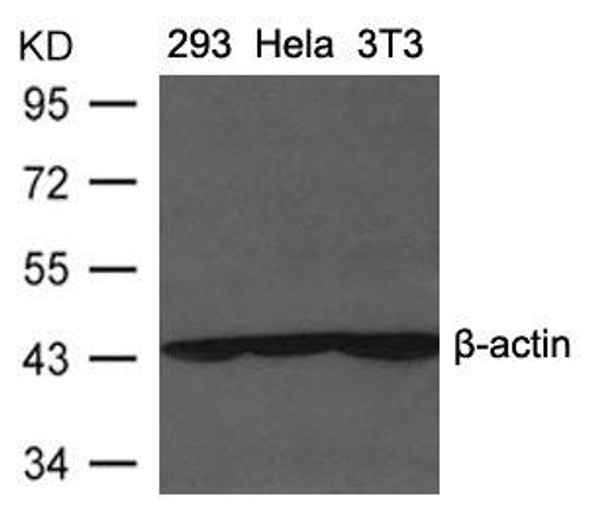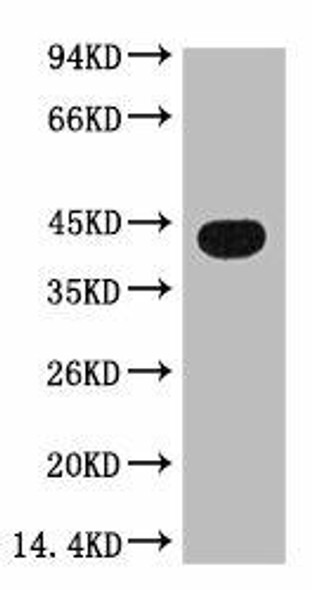ACTB Antibody (PACO17455)
- SKU:
- PACO17455
- Product Type:
- Antibody
- Reactivity:
- Human
- Mouse
- Rat
- Host Species:
- Rabbit
- Isotype:
- IgG
- Applications:
- ELISA
- WB
- Antibody Type:
- Polyclonal Antibody
- Conjugation:
- Unconjugated
Description
ACTB Antibody (PACO17455)
The ACTB Monoclonal Antibody (PAC017455) is a powerful tool for researchers studying Actin, an essential protein involved in cell structure and movement. This antibody, developed using advanced monoclonal technology, is highly specific to Actin and is suitable for various applications, including immunofluorescence and flow cytometry.Actin, a highly conserved protein found in all eukaryotic cells, plays a crucial role in cell motility, division, and shape maintenance. By targeting Actin, researchers can investigate processes such as cell migration, cytoskeletal organization, and intracellular transport. The ACTB Monoclonal Antibody enables precise detection and visualization of Actin in different cell types and tissues, making it an invaluable tool for cell biology and pathology studies.
Furthermore, Actin dysregulation has been implicated in various diseases, including cancer and neurological disorders. Understanding the role of Actin in these conditions is essential for developing targeted therapies and diagnostic tools. The ACTB Monoclonal Antibody provides researchers with a reliable means to explore Actin dynamics and function, paving the way for new insights into disease mechanisms and potential treatment strategies.
| Antibody Name: | ACTB Antibody (PACO17455) |
| Antibody SKU: | PACO17455 |
| Size: | 50ul |
| Host Species: | Rabbit |
| Tested Applications: | ELISA, WB |
| Recommended Dilutions: | ELISA:1:2000-1:10000, WB:1:500-1:2000 |
| Species Reactivity: | Human, Mouse, Rat |
| Immunogen: | Fusion protein of human ACTB |
| Form: | Liquid |
| Storage Buffer: | -20°C, pH7.4 PBS, 0.05% NaN3, 40% Glycerol |
| Purification Method: | Antigen affinity purification |
| Clonality: | Polyclonal |
| Isotype: | IgG |
| Conjugate: | Non-conjugated |
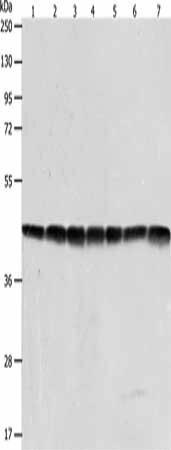 | Gel: 10%SDS-PAGE, Lysate: 40 μg, Lane 1-7: Hela cells, Jurkat cells, NIH/3T3 cells, human fetal liver tissue, mouse brain tissue, A431 cells, 293T cells, Primary antibody: PACO17455(ACTB Antibody) at dilution 1/600, Secondary antibody: Goat anti rabbit IgG at 1/8000 dilution, Exposure time: 7 seconds. |
| Background: | Beta-actin (gene name ACTB) is one of six different actin isoforms which have been identified in humans. This is one of the two nonmuscle cytoskeletal actins. Actins are highly conserved proteins that are involved in cell motility, structure and integrity. α actins are a major constituent of the contractile apparatus. |
| Synonyms: | actin, beta |
| UniProt Protein Function: | Function: Actins are highly conserved proteins that are involved in various types of cell motility and are ubiquitously expressed in all eukaryotic cells. |
| UniProt Protein Details: | Subunit structure: Polymerization of globular actin (G-actin) leads to a structural filament (F-actin) in the form of a two-stranded helix. Each actin can bind to 4 others. Identified in a mRNP granule complex, at least composed of ACTB, ACTN4, DHX9, ERG, HNRNPA1, HNRNPA2B1, HNRNPAB, HNRNPD, HNRNPL, HNRNPR, HNRNPU, HSPA1, HSPA8, IGF2BP1, ILF2, ILF3, NCBP1, NCL, PABPC1, PABPC4, PABPN1, RPLP0, RPS3, RPS3A, RPS4X, RPS8, RPS9, SYNCRIP, TROVE2, YBX1 and untranslated mRNAs. Component of the BAF complex, which includes at least actin (ACTB), ARID1A, ARID1B/BAF250, SMARCA2, SMARCA4/BRG1, ACTL6A/BAF53, ACTL6B/BAF53B, SMARCE1/BAF57 SMARCC1/BAF155, SMARCC2/BAF170, SMARCB1/SNF5/INI1, and one or more of SMARCD1/BAF60A, SMARCD2/BAF60B, or SMARCD3/BAF60C. In muscle cells, the BAF complex also contains DPF3. Found in a complex with XPO6, Ran, ACTB and PFN1. Component of the MLL5-L complex, at least composed of MLL5, STK38, PPP1CA, PPP1CB, PPP1CC, HCFC1, ACTB and OGT. Interacts with XPO6 and EMD. Interacts with ERBB2. Interacts with GCET2. Ref.11 Ref.12 Ref.15 Ref.22 Subcellular location: Cytoplasm cytoskeleton. Note: Localized in cytoplasmic mRNP granules containing untranslated mRNAs. Ref.17 Post-translational modification: ISGylated. Ref.13Oxidation of Met-44 by MICALs (MICAL1, MICAL2 or MICAL3) to form methionine sulfoxide promotes actin filament depolymerization. Methionine sulfoxide is produced stereospecifically, but it is not known whether the (S)-S-oxide or the (R)-S-oxide is produced By similarity. Involvement in Disease: Defects in ACTB are a cause of dystonia juvenile-onset (DYTJ) [ MIM:607371]. DYTJ is a form of dystonia with juvenile onset. Dystonia is defined by the presence of sustained involuntary muscle contraction, often leading to abnormal postures. DYTJ patients manifest progressive, generalized, dopa-unresponsive dystonia, developmental malformations and sensory hearing loss. Ref.23Defects in ACTB are the cause of Baraitser-Winter syndrome type 1 (BRWS1) [ MIM:243310]. A rare developmental disorder characterized by the combination of congenital ptosis, high-arched eyebrows, hypertelorism, ocular colobomata, and a brain malformation consisting of anterior-predominant lissencephaly. Other typical features include postnatal short stature and microcephaly, intellectual disability, seizures, and hearing loss. Ref.25 Miscellaneous: In vertebrates 3 main groups of actin isoforms, alpha, beta and gamma have been identified. The alpha actins are found in muscle tissues and are a major constituent of the contractile apparatus. The beta and gamma actins coexist in most cell types as components of the cytoskeleton and as mediators of internal cell motility. Sequence similarities: Belongs to the actin family. |
| NCBI Summary: | This gene encodes one of six different actin proteins. Actins are highly conserved proteins that are involved in cell motility, structure, and integrity. This actin is a major constituent of the contractile apparatus and one of the two nonmuscle cytoskeletal actins. [provided by RefSeq, Jul 2008] |
| UniProt Code: | P60709 |
| NCBI GenInfo Identifier: | 46397333 |
| NCBI Gene ID: | 60 |
| NCBI Accession: | P60709.1 |
| UniProt Secondary Accession: | P60709,P02570, P70514, P99021, Q11211, Q64316, Q75MN2 Q96B34, Q96HG5, |
| UniProt Related Accession: | P60709 |
| Molecular Weight: | 67 KD |
| NCBI Full Name: | Actin, cytoplasmic 1 |
| NCBI Synonym Full Names: | actin, beta |
| NCBI Official Symbol: | ACTB |
| NCBI Official Synonym Symbols: | BRWS1; PS1TP5BP1 |
| NCBI Protein Information: | actin, cytoplasmic 1; beta cytoskeletal actin; PS1TP5-binding protein 1 |
| UniProt Protein Name: | Actin, cytoplasmic 1 |
| UniProt Synonym Protein Names: | Beta-actin |
| Protein Family: | Actin |
| UniProt Gene Name: | ACTB |
| UniProt Entry Name: | ACTB_HUMAN |
| Secondary Antibody |
| Anti-HRP Goat Anti-Rabbit IgG (H+L) Antibody (CABS014) |
| Recommended Products |
| Anti-FITC Goat Anti-Rabbit IgG (H+L) Antibody (CABS011) |
| Anti-HRP-conjugated Beta Actin Antibody (CABC028) |

